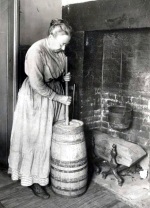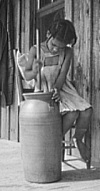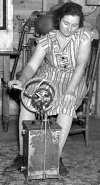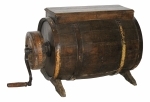-
History of:
- Resources about:
- More:
- Baby walkers
- Bakehouses
- Bed warmers
- Beer, ale mullers
- Besoms, broom-making
- Box, cabinet, and press beds
- Butter crocks, coolers
- Candle snuffers, tallow
- Clothes horses, airers
- Cooking on a peat fire
- Drying grounds
- Enamel cookware
- Fireplaces
- Irons for frills & ruffles
- Knitting sheaths, belts
- Laundry starch
- Log cabin beds
- Lye and chamber-lye
- Mangles
- Marseilles quilts
- Medieval beds
- Rag rugs
- Rushlights, dips & nips
- Straw mattresses
- Sugar cutters - nips & tongs
- Tablecloths
- Tinderboxes
- Washing bats and beetles
- Washing dollies
- List of all articles
Subscribe to RSS feed or get email updates.
... in this country [Canada] most persons adopt the Irish and Scotch method, that of churning the milk, a practice that in our part of England was not known. For my own part I am inclined to prefer the butter churned from cream, as being most economical, unless you chance to have Irish or Scotch servants who prefer buttermilk to new or sweet skimmed milk.
Catharine Parr Traill (née Strickland),The Backwoods of Canada ... The Domestic Economy Of British America, 1836
If you do not throw salt into the fire before you begin to churn, the butter will not come.
Lincolnshire Folk Lore
A hot iron put into the cream during the process of churning, expels the witch from the churn.
Lancashire Folk Lore
(From mid-19th century Notes & Queries magazine)
An old lady a native of Scotland who later came to Prince Edward Island ... said irritably, “I have been churning for nearly an hour and the butter won’t gather; I will have to get the poker.” “The fairies are around again.”
... She told me that sometimes the fairies get into the churn, and it matters not how much you churn, the butter will not gather. The only remedy is to drive them out with a hot poker. ... [She] plunged it into the cream, and began to churn. To my surprise the butter soon began to gather, and so the old lady was quite confident she had driven the fairies from the churn.Red & White Magazine, 1937
Butter-making - home churns and utensils
 Home butter-making took time and energy,
but only needed simple equipment. Low-tech methods were still well-known in rural
parts of developed countries like the USA in the mid-20th century. In the UK it
became less common for ordinary families to make their own butter in the course
of the 19th century, but the old ways were still used on small farms and in the
dairies belonging to grand houses.
Home butter-making took time and energy,
but only needed simple equipment. Low-tech methods were still well-known in rural
parts of developed countries like the USA in the mid-20th century. In the UK it
became less common for ordinary families to make their own butter in the course
of the 19th century, but the old ways were still used on small farms and in the
dairies belonging to grand houses.
After the cow(s) were milked, the milk was left to settle in a cool place, in shallow dishes, also called setting dishes or pancheons, so the cream would rise to the top. (Unless the butter was to be made from whole milk: less common than making it from cream.) Brass and earthenware dishes were used in the UK in the 17th and 18th centuries, with earthenware becoming gradually more popular, as brass sometimes tainted the flavour.
After half a day or so, the cream was skimmed off and put ready for the churn. Small home producers would want to collect a few days of milking to have enough cream to be worth churning, and a little fermentation would "ripen" the flavour. But the cream couldn't be left waiting too long in summer-time.
Cream-skimmers were used to lift off the cream. These worked well if they were shallow with a thin, almost sharp, edge. Skimmers from the last couple of centuries were often saucer-shaped with perforations to catch the cream while letting milk drip back into the pan, just like those used to remove surface "scum" from stock. Brass cream-skimmers on long or short handles are decorative antiques now, but some were much simpler. Anything the right shape would serve the purpose, like this wooden skimmer made to an older design. Other names for these were fleeter, scummer, skimming spoon, skimming ladle.
Churning should take place at least twice a week in summer.
Esther Copley, Cottage Comforts, England 1825
>> shaping, keeping, moulds >> crocks, coolers
Churning
Moving the cream constantly is the churning that actually produces butter by separating out the yellow fat from the buttermilk. Simply shaking it in a closed jamjar for an hour or so will work, or you can swing unseparated milk in an animal skin hung on sticks, an ancient method still used in some parts of the world.
Plunge churn or dash churn
 A stick called a dasher or churn dash was moved up and down by hand in an upright
container, usually made of wood or earthenware, as in the first two pictures on
this page. A
churn lid from 1400 years ago, with a hole for the stick, shows that this
method has a long history. The stick might be perforated, or it could have a wooden
circle, or crossed boards attached, but even with those to help beat the cream,
this method took longer than using the more complex kinds of churn which were introduced
in the 18th century, and became popular in the 19th.
A stick called a dasher or churn dash was moved up and down by hand in an upright
container, usually made of wood or earthenware, as in the first two pictures on
this page. A
churn lid from 1400 years ago, with a hole for the stick, shows that this
method has a long history. The stick might be perforated, or it could have a wooden
circle, or crossed boards attached, but even with those to help beat the cream,
this method took longer than using the more complex kinds of churn which were introduced
in the 18th century, and became popular in the 19th.
Come butter come
Come butter come
Peter stands at the gate
Waiting for a buttered cake
Traditional churning song
The long job had its own rhyme (see right). This was sometimes thought of as a charm to make the cream turn into butter, and sometimes as a song which went with the rhythm of the work. It was widely known on both sides of the Atlantic, with many variations, and was probably already old when mentioned in print in 1685. Many cultures had their own churning songs. Some had other charms and superstitions too. Both in Europe and North America metal objects - like needles, knives or horseshoes - were used to drive away evil influences which might prevent cream from turning to butter.
 Other names for this long-established
kind of churn are 'up and down' churn, churning tub, plunger churn, plumping churn,
knocker churn,
plump-kirn, or plowt-kirn. (Kirn is a Scots and Northern English word for churn.) Other names
for the dash are dasher-staff, churn-staff, churning-stick, plunger, plumper, or
kirn-staff.
Other names for this long-established
kind of churn are 'up and down' churn, churning tub, plunger churn, plumping churn,
knocker churn,
plump-kirn, or plowt-kirn. (Kirn is a Scots and Northern English word for churn.) Other names
for the dash are dasher-staff, churn-staff, churning-stick, plunger, plumper, or
kirn-staff.
Churns based on a pot and stick are used in Asia too. Indian churns are often operated by ropes and pulleys, handled by one or two people. Tibetan yak butter is also made with a dasher in a container, as pictured right.
 Paddle churn
Paddle churn
A wooden box or earthenware crock had a paddle inside attached to a rod, which was turned by a handle on the top or side. These contraptions, which could also be metal, were widely sold as small, convenient household churns in 19th century America, like the wooden one in the photo (right), or this early 20th century glass one in use in the US in the 1940s. This sort of churn was also used for domestic butter-making in New Zealand.
Barrel churn
 The whole churn might be turned round by a handle, or the handle would operate
a crank turning paddles inside the barrel. Some were squarer looking and called
box churns. The French call the kind in the photograph a Norman churn. There were
also barrel- and box-shaped churns which swung or rocked instead of turning. More
elaborate barrel churns were probably for larger-scale farm production and don't
really count as household items.
The whole churn might be turned round by a handle, or the handle would operate
a crank turning paddles inside the barrel. Some were squarer looking and called
box churns. The French call the kind in the photograph a Norman churn. There were
also barrel- and box-shaped churns which swung or rocked instead of turning. More
elaborate barrel churns were probably for larger-scale farm production and don't
really count as household items.
A manual for "country housewives" published in 1750 praised the recently-invented barrel churn:
A barrel churn is so late an invention, that the uses of it are known but in few counties in England. Buckinghamshire and Bedfordshire justly claim the first practice of this most serviceable dairy utensil, that every year comes more and more into fashion, for its being easily and quickly clean'd, as well as its being work'd with much facility and least waste of cream, and expeditiously producing the sweetest butter.
William Ellis, The country housewife's family companion, 1750
>> end over end barrel churns
>> shaping, keeping, moulds, crocks
>> serving, dishes
You may like our new sister site Home Things Past where you'll find articles about antiques, vintage kitchen stuff, crafts, and other things to do with home life in the past. There's space for comments and discussion too. Please do take a look and add your thoughts. (Comments don't appear instantly.)
For sources please refer to the books page, and/or the excerpts quoted on the pages of this website, and note that many links lead to museum sites. Feel free to ask if you're looking for a specific reference - feedback is always welcome anyway. Unfortunately, it's not possible to help you with queries about prices or valuation.


